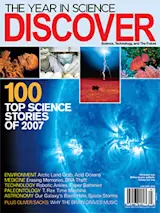Cosmological experiments suggest dark matter really is out there. Data collected with the Hubble Space Telescope is helping astronomers map dark matter in space along with X-ray pictures of colliding galaxies, measurements of cosmic background radiation, and analysis of the way stars on the ends of galactic arms rotate. Physicists think that dark matter provides a gravitational structure for the Universe, influencing—but not usually interacting with—the matter we perceive. But dark matter isn’t just “out there”—we’re searching for it here on Earth as well.
Most dark matter labs are deep underground, minimizing background signals from cosmic radiation. Deep in these dark chambers,modern-day prospectors are coming up with creative ways to detect interactionsbetween dark and known matter, exploiting solids, liquids, and gases. “The race is on [to find the first dark matter particles],” says Florida State University theoretic physicist Howard Baer, a member of the U.S. Dark Matter Scientific Assessment Group.The ...














